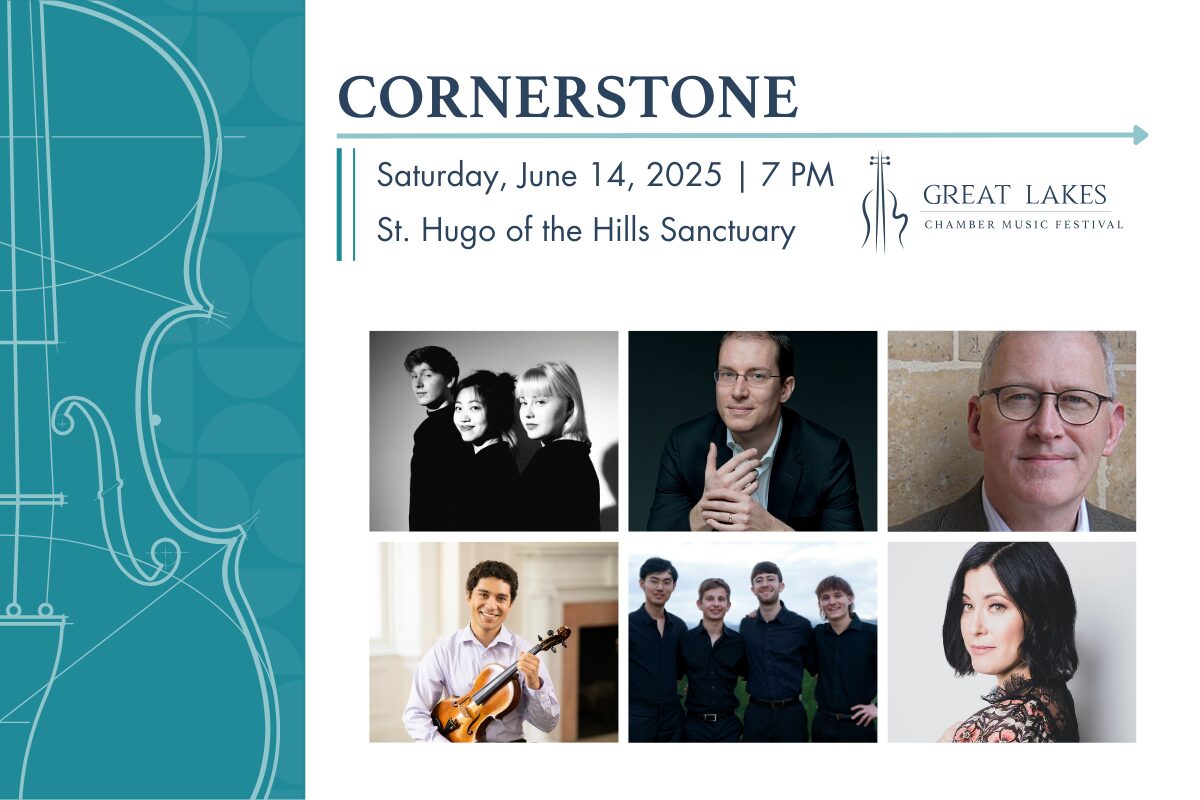Cornerstone

Saturday, June 14; 7:00PM
at St. Hugo of the Hills
©Ty Bouque
—
There is a reverence verging on mania endowed upon the cornerstone. Its sacred affection has nothing to do with its structural support or the quality of materials or even its scale. It is, rather, the first site at which the blueprint becomes a reality, and it is from the position of the cornerstone that the remainder of the structure will be mapped. Its placement, then, is a kind of key: the position of all form can be traced back to the calculations of that single moment. Tonight we will be looking at small building blocks upon which a whole has been built. They’re not always easy to spot, but composers inevitably engrave their cornerstones with a certain quantity of hands-on love that helps them to stand out.
The twin organ concertos on tonight’s program deserve to be discussed in tandem, for that instrument is (at least logistically speaking) what draws this program together.
Poulenc’s is a study in—the cornerstone, an idea as opposed to an object—what we might call gear changes. The notion of stark contrast as both architecture and drama pervades this concerto, a project over which Poulenc toiled for several years. (He wanted both to fulfill the desire of its commissioner—Winaretta Singer, heiress to the Singer sewing fortune and a lesbian socialite of high taste—for a work she, a decent but amateur organist could play, and his own desire for a work of towering artistic achievement. Ultimately he sided with the latter.) Everything—from dynamics to harmonies to density to range—is calculated to sit adjacent to its polar opposite. It is a work which strives at every possible moment to maneuver extremes without sacrificing coherence. (How else can one explain the shock of the quiet ending in the fourth and fifth movements, or the almost abrasive difference in harmonies that modulate across the second?) What is irreconcilable in extremis becomes the project of the concerto, resulting in a work always on the edge of its seat: it can—no, will, desires to—change on a dime.
Handel’s cornerstone, meanwhile—and this is a bit of an odd reading—was himself. Tonight’s Organ Concertois built on an eclectic hodgepodge of themes borrowed from elsewhere in his catalogue, from trio sonatas and earlier works in the same genre. (He’s effectively credited with inaugurating the organ concerto as a form.) Accordingly, long sections of the work remain only sparingly notated because Handel—an organist by training (he studied with an organist in Halle, whose old-school ways were where Handel learned his dazzling fluency in fugues, canons, and counterpoint)—would have improvised the solos. The concerto was one meant to build itself around Handel’s creative mind, a kind of amalgamation of his life and work. (Familiar listeners will, however, spot a not-so-oblique reference to Pachelbel in the second movement.)
Historical curio: Handel’s concerto was published posthumously in a set of six concertos, transcribed in part from barrel organs made by his assistant containing themes and sections of each. These little music-box-like captures allowed later editors to compile these works, once believed to be lost.
And music boxes return as the cornerstone for Hannah Kendall, this week in the role of festival Composer in Residence. Since 2020, the British composer has been accumulating a series of works titled Tuxedo, after the Jean-Michel Basquiat behemoth of the same name. Basquiat’s drawing is immense, fifteen sections of street-art inspired blocks of white text on a black background (the colors inverted from his usual), all of them littered with diagrams and graphics and stacked in columns, topped, at last, with his signature crown. Kendall describes seeing the work in person at New York’s Guggenheim, sitting for two hours in breathless awe before its scale and density. It would be easy, in some ways, to read Tuxedo’s cornerstone as Basquiat himself.
But look closer. In Kendall’s account, Basquiat’s Tuxedo—and the sprawling history of black heritage, resistance, and art contained within it—was Basquiat’s attempt at something “bigger than you and I and it.” Accordingly, Kendall’s series never strives to capture the whole: so gargantuan an undertaking can only really be experienced in snippets and small fragments, glimpses that leave completion to the work of the imagination. Tuxedo: Crown; Sun King continues Kendall’s fascination with small objects of musical-adjacency. Here, a collection of music-boxes—our actual cornerstone—played in overlapping cycles blur the sound field, creating a kind of thick shimmer through which the violin must push to inscribe its rebellious body. The music box as a kind of imperfect memory, an object of hazy nostalgia whose accumulation becomes a kind of dangerous wash, gives the piece its emotional thrust: how the beautiful boxes, through which we interact with our past, often fail to accommodate nostalgia’s violence.
Saint-Saëns’s cornerstone, meanwhile, is not a chord or a key or an object but a texture which encodes a relationship. The cornerstone of the Violin Sonata—written in the Frenchman’s fifties, only a few months before work began on the Carnival of the Animals —is homophony, or unison playing between the two instruments. Reconciliation and togetherness is where the entire Sonata begins, and it is what it’s destined towards, a white-hot blur of unison playing at the very end that crashes into a cadence. Across the work—though especially in the slow movement, where the violin’s hovering line provides static points of reference—the piano chases after the soloist, desperate to reinstate perfect unison if only for an instant. The erotics of touching—of moving in absolute tandem, knowing the other’s every step, thinking two-as-one, when you reach for my hand at the same time I do yours—are at all times what this sonata desires.
—
Desire is curiously inscribed across all four works tonight. Cornerstones, after all, tilt towards the future: from this here point in time and space, one can just begin to envision how the building might come to feel. It is the point where the abstract touches the real—holy indeed.
